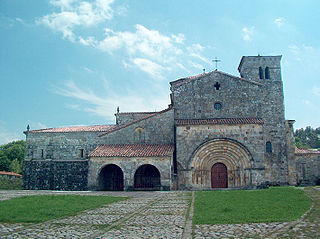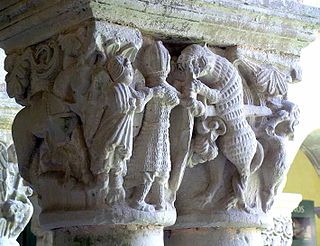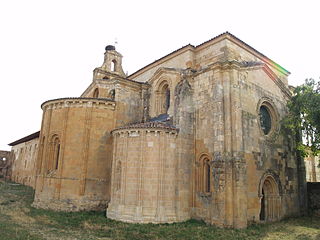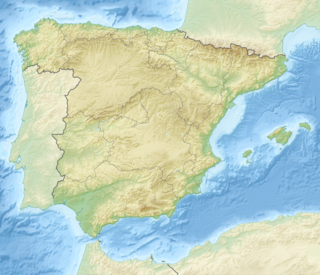Martín Flaínez (or Laíñez) (died May 1108) was "one of the most powerful and distinguished members" of the Leonese aristocracy during the reign of Alfonso VI (1065–1109), with which the length of his public life almost exactly coincided. From 1090 until his death he was a regular figure at the royal court, and even used the title gracia Dei comite, "count by the grace of God". [1]
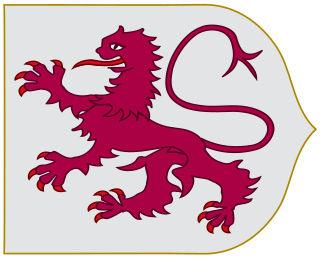
The Kingdom of León was an independent kingdom situated in the northwest region of the Iberian Peninsula. It was founded in AD 910 when the Christian princes of Asturias along the northern coast of the peninsula shifted their capital from Oviedo to the city of León. The County of Castile separated in 931, the County of Portugal separated to become the independent Kingdom of Portugal in 1139 and the eastern, inland part of León was joined to the Kingdom of Castile in 1230.

Martín was a son of Flaín Fernández, son of Count Fernando Flaínez, and his second wife, Toda. The first documentary record of Martín dates to 28 May 1065, when he participated in a donation to León Cathedral. His brother Fernando, the royal alférez , fell out with the king in 1077 and was banned from court. It fell to Martín to restore the family's fortunes. [1]
Fernando Flaínez was a powerful magnate from the Kingdom of León, member of the aristocratic lineage of the Flaínez. His parents were Flaín Muñoz and his wife Justa Fernández, daughter of count Fernando Bermúdez de Cea. He was the paternal grandfather of Jimena Díaz, wife of Rodrigo Díaz de Vivar El Cid, and the direct ancestor of the important medieval noble lineage of the Osorios. He married Elvira Peláez, daughter of Pelayo Rodríguez and Gotina Fernández de Cea, with whom he had at least seven children: Flaín, Oveco, Justa, Pedro, Pelayo, Muño and Diego. He was the tenente of Aguilar and documented with the title of count as of 1028. Jointly with his son, Flaín Fernández, he governed the city of León until 1038 when the kingdom was already under the control of King Sancho III of Pamplona.

Santa María de León Cathedral, also called The House of Light or the Pulchra Leonina is situated in the city of León in north-western Spain. It was built on the site of previous Roman baths of the 2nd century which, 800 years later, king Ordoño II converted into a palace.
In medieval Iberia, an alférez or alferes was a high-ranking official in the household of a king or magnate. The term is derived from the Arabic الفارس (al-fāris), meaning "horseman" or "cavalier", and it was commonly Latinised as alferiz or alferis, although it was also translated into Latin as armiger or armentarius, meaning "armour-bearer". The connexion with arms-bearing is visible in several Latin synonyms: fertorarius, inferartis, and offertor. The office was sometimes the same as that of the standard-bearer or signifer. The alférez was generally the next highest-ranking official after the majordomo. He was generally in charge of the king or magnate's mesnada, his personal retinue of knights, and perhaps also of his armoury and his guard. He generally followed his lord on campaign and into battle.
Martín married Sancha Fernández sometime before 13 November 1084, when the couple first appear beside each other in a document. Sancha was a daughter of Tegridia Gutiérrez, daughter of Gutier Alfonso. She gave him four sons, [2] who all died in battle: Gómez, Osorio, Pedro [3] and Rodrigo. The couple also had a daughter named for her maternal grandmother, Tegridia. There survives an interesting description of a manor house purchased by Martín and his wife sometime before 1085. It included a kitchen, pond, strawloft and threshing floor. [4] In May 1085 they granted it to Arias Núñez for his loyal service.

Osorio Martínez was a magnate from the Province of León in the Empire of Alfonso VII. He served the emperor militarily throughout his long career, which peaked in 1138–41. Besides the documentary sources, which are somewhat meagre at times after his fall from royal favour, he is mentioned in two episodes in the Chronica Adefonsi imperatoris. He supported Ferdinand II of León after Alfonso's death (1157), but he died in a Castilian civil war in 1160.

Rodrigo Martínez was a Leonese nobleman, landowner, courtier, military leader, governor, and diplomat, "the most powerful lay figure in the region of the western Tierra de Campos," who "emerges as far and away the most regular visitor to the court of Alfonso VII between 1127 and 1138." He was a member of the Flagínez family, rose to the highest rank in the kingdom and met his end on the battlefield.
On two isolated occasions before 1090—in October 1075 and December 1080, specifically—Martín is given the title comes (count), the highest in the kingdom, but he does not consistently use this title until after the summer of 1090. [1] It is only then that his political career begins. At that time he was tenant of Aguilar, which he continued to govern on behalf of the crown until his death, although he is last cited there on 16 January 1108. Between 1 February 1091 and 7 February 1092 he received the tenancy of the castle of Simancas, which had previously been held by Pedro Alfonso. At the same time (February 1092) he appears as tenant in Cabezón. Between April 1101 to June 1107 he was tenant in San Julián, and there are brief notices of his tenancies elsewhere: Ceón in June 1104, Peñamián in May 1105 and León in December 1106. [1]
Count (Male), or Countess (Female), is a historical title of nobility in certain European countries, varying in relative status, generally of middling rank in the hierarchy of nobility. The etymologically related English term, "county" denoted the land owned by a count. Equivalents of the rank of count exist or have existed in the nobility structures of some non-European countries, such as hakushaku during the Japanese Imperial era.

Aguilar de Campoo is a town in the province of Palencia, autonomous community of Castile and León, Spain. It is close to the River Pisuerga. Its 2011 population is 7741.

Simancas is a town and municipality of central Spain, located in the province of Valladolid, part of the autonomous community of Castile and León. It is situated approximately 10 km southwest of the provincial capital Valladolid, on the road to Zamora and the right bank of the river Pisuerga.
Martín's known pious endowments are limited. He made a grant to the Benedictine monasteries of Sahagún in March 1091, and also to the regular clergy of Valladolid in February 1092. [1] He was not always on good terms with Sahagún: in 1091 he had to defend the settlers of Villavicencio in their dispute with Sahagún. At an unknown date when his son Rodrigo was young, he made a donation of a meadow, some money and candles to the Benedictine house of Santa Eugenia de Cordovilla, whose monks, he claimed, had exorcised a demon from his son. On 22 September 1102 Martín granted some land at Torredillos to the townsmen that they might build a church. [1]

Sahagún is a town in the province of León, Spain. It is the main town of the Leonese section of the Tierra de Campos district.
Regular clergy, or just regulars, is applied in the Roman Catholic Church to clerics who follow a "rule" in their life, those who are members of religious institutes. Formerly, it meant those who were members of Catholic religious orders, institutes in which at some least of the members made solemn profession. It contrasts with secular clergy.

Valladolid is a city in Spain and the de facto capital of the autonomous community of Castile and León. It has a population of 309,714 people, making it Spain's 13th most populous municipality and northwestern Spain's biggest city. Its metropolitan area ranks 20th in Spain with a population of 414,244 people in 23 municipalities.
According to Lucas de Tuy, writing his Chronicon mundi over a hundred years later, Martín was a victim of the Battle of Uclés in May 1108. A charter of the monastery of Sahagún dated 17 November 1108 cites Martín as still living, although it may contain an error in the dating clause. There is no other reference to Martín later than 31 March 1108. [1] There is no reference to his eldest son, Gómez, after May 1107, and it is probable that he died in the same engagement as his father. [5] He was buried in Sahagún.
Lucas de Tui was a Leonese cleric and intellectual, remembered best as a historian. He was Bishop of Tuy from 1239 until his death.

The Battle of Uclés was fought on 29 May 1108 during the Reconquista period near Uclés just south of the river Tagus between the Christian forces of Castile and León under Alfonso VI and the forces of the Muslim Almoravids under Tamim ibn-Yusuf. The battle was a disaster for the Christians and many of the high nobility of León, including seven counts, died in the fray or were beheaded afterwards, while the heir-apparent, Sancho Alfónsez, was murdered by villagers while trying to flee. Despite this, the Almoravids could not capitalise on their success in the open field by taking Toledo.
